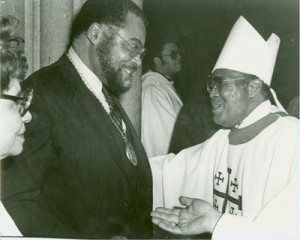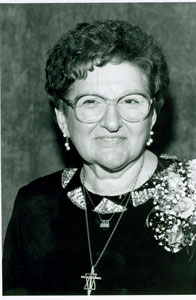by Jeanne Brasile
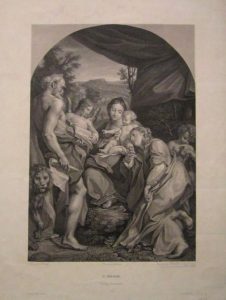
engraving after Francesco Bartolozzi by Karl Heinrich-Muller
19th century
2012.00.0032
November 1 is the annual celebration of All Saints Day which honors all Catholic saints, particularly those with no special feast day of their own. All Saints Day is celebrated worldwide by Roman Catholics as well as other Christian denominations. A feast day commemorates a saint or saints who are remembered on their individual feast days with special services and prayers. Certain feast days include public celebrations and processions. Some saints are celebrated internationally, while others are honored regionally or locally.
All Saints Day was first observed under Pope Boniface IV on May 1, 609 when he dedicated Rome’s Pantheon to the Virgin Mary and the Martyrs. Pope Boniface also instituted All Souls Day, an additional day of prayer and remembrance for the souls of those who have died. Celebrated on November 2, it immediately follows All Saints Day.[1] In the 8th century, Pope Gregory III moved the All Saints Day observance to November 1, though celebrations were local to Rome. Under Pope Gregory IV, All Saints Day became an official worldwide observance for the entirety of the church.[2]
Prior to the 10th century, there was no formalized process for identifying and sanctifying saints. This was addressed by Pope John XV who defined the parameters for sainthood. Previous to Pope John XV, sainthood was often attained through popular public opinion. Today, there are more than 10,000 recognized saints.[3] The Catholic Online website has a comprehensive list of saints, angels and feast days – in addition to a wealth of other Catholic resources. It will give you a sense of the many saints venerated in the Roman Catholic Church, and it is fun to browse. For instance, did you know Saint Bernardino is the patron saint of advertising and communications? Or that Saint Januarius is the patron saint of blood banks, and in Naples, also volcanoes? Seton Hall University’s Walsh Gallery and Archives and Special Collections have a significant number of collections that featuring various Catholic saints. In honor of All Saints Day, we have assembled these images of art and artifacts featuring those who have been canonized.

2018.17.0001.a
Saint Elizabeth Ann Seton, the University’s namesake, is the patron saint of Catholic schools, widows, and seafarers. She is also the aunt of the university’s founder, The Most Reverend, James Roosevelt Bayley. This image of Saint Elizabeth Ann Seton is from a medal designed for the Society of the Preservation of Setonia. This design was made in advance of Saint Elizabeth Ann Seton’s canonization which occurred in 1975. This medal design, in addition to numerous other artifacts that illuminate the life and work of Saint Elizabeth Ann Seton are currently on display in the Walsh Gallery exhibition “The Treasures of Seton Hall University.” Her feast day is January 4.
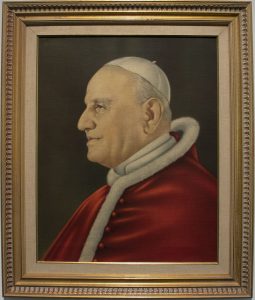
20th century
2021.12.0001
Courtesy of the Archives of the Archdiocese of Newark
Saint Pope John XXIII is one of the most popular popes in the Roman Catholic Church. He ushered in a new era by convening the Second Vatican Council (1962 – 1965), popularly known as Vatican II. This council resulted in sweeping changes throughout the church to address the modern era. Canonized by Pope Francis in April 2014, Saint Pope John XXIII’s feast day is October 11. He is the patron saint of Papal delegates, the Patriarchy of Venice and the Second Vatican Council.[4] Saint John XXIII was also the pope that beatified Saint Elizabeth Ann Seton. Beatification, a precursor to canonization or sainthood, is a declaration of blessedness.
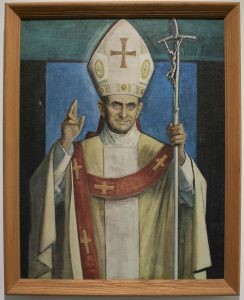
mid to late 20th century
2021.11.0001
Courtesy of the Archives of the Archdiocese of Newark
Saint Pope Paul VI was the 262nd pope of the Roman Catholic Church, succeeding John XXIII as pope. He also presided over Vatican II, closing the session in 1965 which resulted in numerous church reforms including the improvement of relations with the Eastern Orthodox and Protestant churches. Saint Pope Paul VI canonized Saint Elizabeth Ann Seton in 1975. He was in turn beatified and canonized by Pope Francis in 2014 and 2018, respectively.[5] His feast day is May 29th.
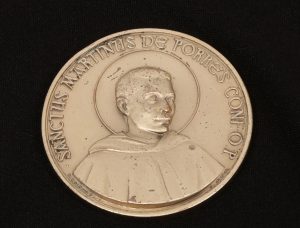
1962
2021.01.0011
Gift of Peter Ahr
Saint Martín de Porres (1579 – 1639), a Peruvian born saint ,was associated with the Dominican Order. He was known for caring for the sick, was trained in the healing arts and was also barber. Though he was devoted to the church, at that time his lineage prevented him from taking his vows as the son of an unmarried Spanish nobleman and a mother that was a freed slave of African and Native descent. Like Saint Elizabeth Ann Seton, he founded orphanages and was devoted to the cause of education. He is the patron saint of mixed race people, public health workers, public schools, public education, the poor, Peru, innkeepers and barbers as well as lottery winners, racial harmony and social justice.[6] Today, his name graces numerous schools throughout the United States as well as a Catholic University in Lima, Peru.

December 10, 1896 – vol. 1, no. 10
BX801 .A55
Courtesy of Archives and Special Collections
Saint Kateri Tekakwitha (1656 – 1680), whose feast day falls on July 14th, is the first Native American saint recognized by the Catholic Church. A layperson of Algonquin-Mohawk heritage, she was born in the Mohawk village of Ossernenon which sits on the banks of New York States’ Mohawk River. She was the daughter of Kenneronkwa, a Mohawk chief, and Kahenta, an Algonquin woman who had been captured in a raid, then taken into the Mohawk tribe.[7] In Saint Kateri Tekakwitha’s time, the Mohawks had considerable contact with other tribes, as well as European trappers, traders and missionaries. A resulting outbreak of smallpox took the lives of the Saint Kateri Tekakwitha’s parents and brother. She survived, but with lasting health implications. At the age of 18, after meeting a Jesuit priest, she converted to Catholicism, dying just a few short years later at the age of 24.[8] She was beatified in 1980 by Pope John Paul II, and canonized by Pope Benedict XVI at Saint Peter’s Basilica October 21, 2012.[9] Saint Kateri Tekakwitha is the patron saint of the environment, ecology, those who have lost their parents, people in exile and Native Americans.[10]
A mass in honor of All Saints Day will be held at the Chapel of the Immaculate Conception at Seton Hall University at 11am on November 1.
The images and materials shown here are but a small part of the vast patrimony available to students, faculty and researchers. For access to this or other objects in our collections, complete a research request form to set up an appointment or contact us at 973-761-9476
[1] https://www.catholic.org/saints/allsaints/ accessed 10/25/2021
[2] https://www.cnn.com/2020/11/01/world/all-saints-day-trnd/index.html accessed 10/25/2021
[3] https://www.britannica.com/story/roman-catholic-saints-hallowed-from-the-other-side accessed 10/23/2021
[4] https://www.catholic.org/saints/saint.php?saint_id=7305 accessed 10/26/2021
[5] https://en.wikipedia.org/wiki/Pope_Paul_VI accessed 10/25/2026
[6] https://en.wikipedia.org/wiki/Martin_de_Porres accessed 10/25/2021
[7] https://www.catholic.org/saints/saint.php?saint_id=154 accessed 10/26/2021
[8] https://www.kateri.org/our-patron-saint/ accessed 10/26/2021
[9] https://en.wikipedia.org/wiki/Kateri_Tekakwitha accessed 10/25/2021
[10] https://en.wikipedia.org/wiki/Kateri_Tekakwitha accessed 10/26/2021
